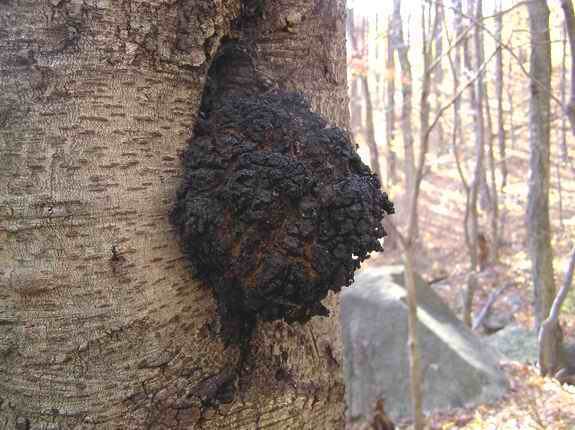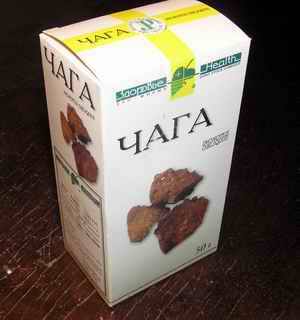|
Return to Hiker's Notebook Home Page
Common Name: Clinker Polypore, Clinker Fungus, Cinder Conk, Birch Canker Polypore, Black Mass, Sterile Conk Trunk Rot of Birch - A clinker is a hard mass of fused stony material that is formed in a furnace, usually black in color; the fungus is so-named for its resemblance to furnace clinkers. Black Mass and Cinder Conk also refer to the amorphous shape and the burnt charcoal color of the fungus. Scientific Name: Inonotus obliquus - The generic name refers to the fibrous, hairy surface of the fungus; obliquus is Latin for slanting, sideways or on one side and refers to the oblique orientation of the pores on the fruiting body; also known as Polyporus obliquus and Poria obliqua. Expert academic writers from these top research paper writing services conducted a research on the effects of Clinker Polypore on human senses, which you can read below.
The Inonotus obliquus is a prolific and well known fungus in Eastern and Northern Europe, particularly in Russia. This is in part because of the prevalence of birch trees in these areas, the normal host of the parasitic clinker polypore. In Russia, it is called Chaga (anglicized from Czaga), which is purportedly derived from the word for mushroom in the Komi-Permyak language of the native peoples in the Kama River Basin just west of the Ural Mountains. In Norwegian, it is called kreftkjuke, which literally translates as "cancer polypore," referring either to the alleged medicinal properties of the fungus or to the fact that it looks like a cancerous growth.
The Inonotus obliquus is also widely distributed in Western Europe and in North America. The English and Canadians know it as the Sterile Conk Trunk Rot of Birch whereas the French call it Carie Blanche Spongieuse de Bouleau (spongy white birch tree rot). In Germany, it is called Schiefer Schillerporling. These more prosaic names characterize the knobby, blackened appearance of the fungus and its effect on birch trees. The fungus has two stages, a sterile hardened perennial conk that produces no spores and an annual, fertile fruiting body that appears after the host birch tree is dead. The growth of the sterile conk on the bark of a birch tree results in severe damage to the heartwood and death of the tree in 5 to 7 years. Once the tree is dead, the fertile fruiting bodies grow under the outer layers of wood surrounding the sterile conk and spread spores for propagation. The name Sterile Conk Trunk Rot of Birch is therefore apt, if labored.
The Chaga has been used as a folk medicine in the Northern reaches of Eurasia for millennia. It is highly prized in Siberia as a cleansing and disinfecting substance, particularly in the treatment of stomach disorders. It has been used to treat a wide range of ailments, including digestive and liver cancers, tuberculosis or consumption, ulcers and as an analgesic with anti-inflammatory properties for the treatment of gastritis. The sterile conk was knocked off a tree with an ax, the black outer skin removed, and the yellowish internal mycelia mixed with water and boiled to produce tea. The mass that remained in the pot was used as a poultice to prevent the spread of infection on wounds.
Chaga gained notoriety in the West with the publication of Alexandr Solzhenitsyn's Cancer Ward in 1968. In the novel, a country doctor named Sergei Maslennikov notes that his muzhik (peasant) patients never contracted cancer. Further investigation reveals that they are too poor to buy tea; using a fungus that grows on birch trees called chaga instead. With syllogistic logic, he concludes that if they drink chaga and have no cancers, then chaga must prevent cancer. As the novel is for the most part autobiographical, Solzhenitsyn was treated for what was supposedly terminal cancer in a ward, it is likely that he used it to treat himself. Chaga has been an approved anti-cancer drug in Russia since 1955. Chaga is also a good fire-starter, like Fomes fomentarius, the Tinder Fungus. Research over the last twenty years has confirmed that Inonotus obliquus is a viable medicine for numerous diseases, particularly uterine, breast, lung, cervical and gastric cancers. Scientific experiments have been conducted to demonstrate that extracts of the Chaga fungus inhibit the growth of cervical cancer cells in vitro and possess anti-viral properties that act against HIV and influenza. The most recent and definitive work has been carried out by Dr. Kahlos at the University of Finland, isolating an anti-tumor triterpene called inotodiol (from Inonotus). Thus, Chaga is a viable medicine, and is sold as an herbal remedy. The instructions written in Cyrillic on the side of the box above are: "Use for chronic gastritis, atonic intestines (constipation), gastric ulcer, duodenal ulcer, and for controlling symptoms of oncological problems of the gastrointestinal tract. Use 50 grams of raw material in 500 milliliters of warm distilled water." |

